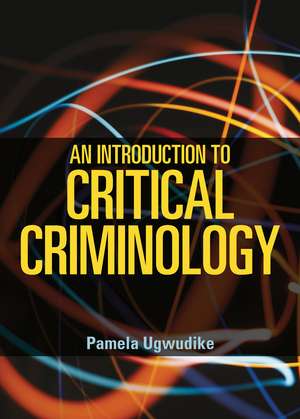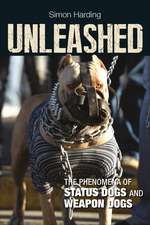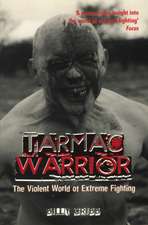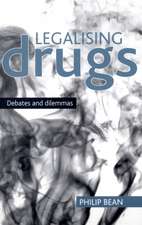An Introduction to Critical Criminology
Autor Pamela Ugwudikeen Limba Engleză Paperback – 26 feb 2015
The first book on critical criminology theories and perspectives for students of criminology, sociology, and social policy, this book offers an in-depth but accessible introduction to foundational and contemporary ideas in the field. Using examples, highlighting key points, and offering sample essay questions, Pamela Ugwudike presents students with a vast array of theories and perspectives, including many that challenge mainstream criminological notions about the causes of crime and the operation of the criminal justice system. Aiming not only to familiarize students with these concepts but also to encourage them to develop critical thinking, An Introduction to Critical Criminology will be an ideal text for criminology courses.
| Toate formatele și edițiile | Preț | Express |
|---|---|---|
| Paperback (1) | 331.33 lei 22-36 zile | |
| Bristol University Press – 26 feb 2015 | 331.33 lei 22-36 zile | |
| Hardback (1) | 782.40 lei 43-57 zile | |
| Bristol University Press – 26 feb 2015 | 782.40 lei 43-57 zile |
Preț: 331.33 lei
Nou
Puncte Express: 497
Preț estimativ în valută:
63.40€ • 66.36$ • 52.77£
63.40€ • 66.36$ • 52.77£
Carte disponibilă
Livrare economică 10-24 martie
Preluare comenzi: 021 569.72.76
Specificații
ISBN-13: 9781447309420
ISBN-10: 1447309421
Pagini: 272
Dimensiuni: 171 x 241 x 18 mm
Greutate: 0.52 kg
Editura: Bristol University Press
Colecția Policy Press
ISBN-10: 1447309421
Pagini: 272
Dimensiuni: 171 x 241 x 18 mm
Greutate: 0.52 kg
Editura: Bristol University Press
Colecția Policy Press
Notă biografică
Pamela Ugwudike is a senior lecturer in criminology at the School of Law, Swansea University, UK. She is the editor of What Works in Offender Compliance: International Perspectives and Evidence-Based Practice.
Cuprins
Introduction
Part One: Foundational critical criminology
One: What is critical criminology?
Two: The labelling perspective
Three: Conflict perspectives in criminology
Four: Marxist criminology
Part Two: Critiquing foundational critical criminology: challenges from Left and Right
Five: The advent of neo-conservative criminology
Six: Left realism: criticisms from within?
Seven: Feminist critiques
Part Three: Contemporary critical criminology
Eight: Critical perspectives on crimes of the powerful
Nine: Green criminology
Ten: Cultural criminology
Eleven: Critical Race Theory
Part Four: Critical perspectives on punishment
Twelve: Punishment and control
Part Five: Conclusions
Thirteen: Future directions in critical criminology.
Part One: Foundational critical criminology
One: What is critical criminology?
Two: The labelling perspective
Three: Conflict perspectives in criminology
Four: Marxist criminology
Part Two: Critiquing foundational critical criminology: challenges from Left and Right
Five: The advent of neo-conservative criminology
Six: Left realism: criticisms from within?
Seven: Feminist critiques
Part Three: Contemporary critical criminology
Eight: Critical perspectives on crimes of the powerful
Nine: Green criminology
Ten: Cultural criminology
Eleven: Critical Race Theory
Part Four: Critical perspectives on punishment
Twelve: Punishment and control
Part Five: Conclusions
Thirteen: Future directions in critical criminology.
Recenzii
“An incisive introduction to critical criminology that is rich in theoretical concepts and illustrated with vivid examples. This is a valuable resource for scholars and students alike.”
“Ugwudike has done an excellent job, drawing together many of the radical, critical, and conflict voices and perspectives in criminology, while evaluating them in a way that will be both interesting and accessible for readers.”
“This clearly written introduction is a welcome addition. Ugwudike presents complex ideas in an accessible fashion, revealing the weighty contribution of critical perspectives within criminology and including underrepresented feminist and critical race theories.”
“A wonderfully written account of both the foundations and contemporary theoretical priorities of critical criminologists. Essential reading for students, teachers, and researchers.”














